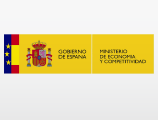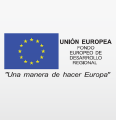Research
Experiments with Ion Traps
- Responsible: Daniel Rodríguez (University Professor)
The Ion Traps group of the University of Granada is the first experimental group of the Department of Atomic, Molecular and Nuclear Physics of the UGR. In 2009 Daniel Rodríguez arrived at the University of Granada and joined a project led by Antonio M. Lallena. That year he obtained a Ramón y Cajal contract and in January 2011 he started his first National R&D project. In November 2011 he was awarded with a Starting Grant from the European Research Council. Many students from different academic levels, most of them graduates from the University of Granada, have participated in this activity. The Ion Traps group is part of the PAIDI Group FQM387: Fundamental Physics and Applications.
The Ion Traps and Lasers Laboratory at the University of Granada is the only laboratory of its kind in Spain. It began construction in March 2012 as part of the TRAPSENSOR project funded by the European Research Council. In addition, Daniel Rodríguez has obtained funding from R&D projects from the MICIU, from Junta de Andalucía and infrastructure projects, co-financed with FEDER funds and by the UGR. The total funding obtained ampunts to about 4.8 million euros, to which must be added a large number of personnel contracts from different programs. Three types of experiments are currently being carried out: 1) Quantum Mass Spectrometry in a 7 Tesla Penning trap, 2) resonant detection of trapped ions with quartz amplifiers (in the same Penning trap), and 3) basic experiments of a quantum nature.
The Ion Traps and Lasers Laboratory of the UGR was named Singular Laboratory in Advanced Technologies of the UGR in March 2017, during the last months of a project from the European Research Council entitled TRAPSENSOR: High-performance Mass Spectrometry Using a Quantum Sensor. At that time the total funding obtained was slightly over three million euros. This laboratory has been a pioneer in the development of quantum optics techniques applied to mass measurements in nuclear physics Applied Physics B: Lasers and Optics 107, 1031–1042 (2012), with the original motivation to improve the accuracy and sensitivity of Penning trap mass measurements for super-heavy elements produced in fusion-evaporation reactions which are difficult to access due to their low production rates Nature, 463, 785-788 (2010), Science 337, 1207-1210 (2012). The use of quantum optics techniques and nuclear physics experiments gives the group a multidisciplinary character.
Active collaborators of the laboratory include the superheavy elements division of the GSI Darmstadt in Germany (SHIPTRAP facility) and the Real Observatorio de la Armada in San Fernando, where an optical clock based on strontium atoms is under construction. There is also collaboration with Spanish theoretical groups, such as the QUINFOG group of the Institute of Fundamental Physics of CSIC and the Quantum Technologies group of the Polytechnic University of Cartagena.
In addition to the uniqueness of the research, the laboratory has an important educational component in two official masters, the Master in Physics of the University of Granada and the Interuniversity Master in Quantum Technologies.
There are currently two platforms in operation: a Penning trap beamline and a linear Paul trap. The most relevant research line is Quantum Mass Spectrometry Europhysics Letters-Perspective 134, 38001 (2021) with thorium, since this element has an isotope proposed as a nuclear clock. In September 2018, the first Doppler cooling test of 40Ca+ ions in the 7 T Penning trap was observed New Journal of Physics 21, 023023 (2019). In 2021, the first Coulomb crystals of 40Ca+-40Ca+ Penning trap ions were generated Physical Review A 105, 052603 (2022). In October 2022, the first relevant measurements using the 40Ca+ ion as a sensor were carried out [Physical Review Research 6, L012001 (2024)]. In November 2022, the 42Ca+-40Ca+ crystals could be observed and probed Physical Review A 110, 063107 (2024) and 232Th+ - 40Ca+ and 232ThO2+ - 40Ca+ (the latter results unpublished pending completion of measurements). The need was found to optimize and characterize the sympathetic cooling process up to the Doppler limit and up to the ground state, the latter to start making measurements of quantum nature whose results would improve those obtained with other methods. Reaching the quantum regime will make it possible to achieve the highest sensitivity and universality of the technique, that is, to make it applicable to any ion regardless of its mass, something that is not possible in radiofrequency traps or in Penning traps using other techniques.
In December 2022 a major refurbishment of the laboratory begins with the replacement of the superconducting magnet (which provides the 7 T magnetic field for the Penning trap), by a one free of liquid helium and liquid nitrogen. This entails additional works and equipment, reaching in July 2024 the conditions of the experiment before the upgrade. In order to carry out experiments of quantum nature, between 2021 and 2023, two lasers coupled to high finesse cavities were tuned to achieve a narrow linewidth for the S1/2-->D5/2 transition (clock or qubit transition) in 40Ca+ (sensor ion), to cool down to the ground State energy such ion and perform experiments of quantum nature.
Another line of research in the lab is the non-destructive detection of trapped ions using quartz resonators, which has involved developments of amplifiers for non-destructive detection of trapped ions in Spain, with a UGR spin-off company, improved in 2018 during a stay of Daniel Rodríguez as a visiting professor at JGU Mainz. The principle behind the technique, known as Fourier-Transform Ion-Cyclotron-Cyclotron-Resonance Mass-Spectrometry (FT-ICR MS), originates from chemistry, where ultra-high precision is not required. In these cases, the aim is to determine the masses of molecular ions that appear when analyzing samples of interest, for example, in biopharmaceuticals, or in petroleum chemistry. In November 2018, the Lab group observed the first signal from ions trapped in the UGR 7-tesla Penning trap Review of Scientific Instruments 90, 063202 (2019), using for the first time a quartz resonator instead of a superconducting helical coil. In 2021, the first coupling between a quartz resonator and trapped ions was published Quantum Science and Technology 6, 044002 (2021). In 2023, based on these measurements, the group, in collaboration with a theoretical group, published the interaction between the trapped ions and the quartz resonator describing it with a coupled quantum oscillator model Physical Review A 107, 053116 (2023).
The Linear Paul trap was initially built as a test bench for the 7-tesla Penning trap as part of a master's thesis and to begin to carry out simple experiments of a quantum nature. It is now possible to image ion crystals cooled to the Doppler limit and identification measurements have been made using the photon signal from the sensor ion Physical Review Research 6, 043255 (2024). Experiments of a quantum nature have been carried out to measure eigenfrequencies of two-ion hybrid Coulomb crystal modes, the publication of which is under preparation.





